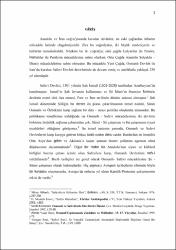| dc.contributor.advisor | Ateş, Abdurrahman | |
| dc.contributor.author | Konuk, Yunus Emre | |
| dc.date.accessioned | 2015-03-27T12:15:08Z | |
| dc.date.available | 2015-03-27T12:15:08Z | |
| dc.date.issued | 2005 | |
| dc.date.submitted | 2005 | |
| dc.identifier.uri | http://hdl.handle.net/11630/3478 | |
| dc.description.abstract | Osmanlı Devleti, kuruluşundan XVI. Yüzyıla kadar, birçok devletle ilişki içinde olmuştur. Ancak XVI. Yüzyılın başından XVII. Yüzyılın ortalarına kadar, Devletin doğudaki en büyük meselesi Safeviler oldu. IV. Murat’ın başa geçişinin hemen ardından yaşanan Bekir Subaşı isyanıyla, Osmanlının en önemli eyaletlerinden biri olan Bağdad Safevilerin eline geçti. Doğudan gelen ticaret yolları üzerinde olmasının yanı sıra, içinde Sünniler için manevi bir değeri olan İmam-ı Azam Ebu Hanefi türbesinin bulunması, buna karşın Şiilerin kutsal saydıkları Kerbela ve Necef’in de Bağdad eyaleti sınırları içinde yer alması, bölgenin hassasiyetini gözler önüne seriyor. İki devlet de Bağdad’a sahip olmak için hiçbir fedakarlıktan kaçınmamıştır.
IV. Murat’ın ilk saltanat döneminde, Bağdad üzerine üç sefer düzenlendi. Sultanın henüz çocuk yaşta olması nedeniyle, Veziriazamların önderliğinde yapılan bu seferler hiçbir sonuca ulaşılamadığı gibi, Bağdad ele geçirilemedi. Büyük askeri ve mali kayıplar verildi. 1632 yılında Sultan Murad, idareye tam anlamıyla hakim olduktan sonra, ilk hedefi Safeviler oldu. 1635’de Revan’a yürüdü ve 10 gün süren kuşatmanın ardından Revan Kalesi ele geçirildi. Ardından Bağdad’a yürüme düşüncesinde olan Sultan, hastalığı sebebiyle geri dönmek zorunda kaldı. Revan ise, bastıran kış mevsimini fırsat bilen Şah Safi tarafından, 6 ay sonra tekrar Safevi topraklarına katıldı.
Bu kayıp, Sultan Murad’ın bizzat başında olacağı ikinci büyük Doğu seferini zorunlu hale getirdi. Nitekim Sultanın Safevilere duyduğu kin iyice artmıştı. 1636’dan itibaren, Doğu seferi hazırlıkları başlamıştı. 1638’de Sultan Murad, ordusunun başında Bağdad üzerine yürüdü. Musul’dayken, ordunun bir kısmını Revan üzerine yolladı ve ardından Bağdad kuşatıldı. 40 gün süren kuşatmadan sonra kale ele geçirildi. Sultan iyice şiddetlenen hastalığı yüzünden İstanbul’a dönmeye karar verdi ve Veziriazam Kara Mustafa Paşayı Bağdad’ta bırakarak, Safevilerle yapılacak barış görüşmelerine tayin etti. Veziriazam İran içlerine yürüyüşe geçtiği sırada, Safevi Şahı Safi barışa razı oldu. 1639’da Zehab Ovası yakınındaki Kasr-ı Şirin’de Safevilerle barış antlaşması imzalandı. Antlaşma metni, tasdiklenmek üzere İstanbul’a yollandı ve Sultanın onayından geçti. Böylece İran ve Osmanlı arasında uzun yıllar sürecek bir barış dönemi başladı. Kasr-ı Şirin’de çizilen sınır ise günümüze kadar geçerliliğini korudu. Bu bakımdan, yapılan antlaşmanın ne denli gerçekçi olduğu şüphe götürmez bir gerçektir. | en_US |
| dc.description.abstract | The Ottoman Porte was in good company with many goverments beginning from its establishment to the 16th century. The greatest problem for the government from the beginning to the midst of the 17th century were the Safavis. With the Bekir Subasi insurgence, immediately after Murad IV succeeded to the throne, Baghdad, one of the most important states of the of the Ottoman Empire, was captured by the Safavis. Besides being situated on the trade roads running from the east, the existence of both, Imam-ı Azam Ebu Hanefi’s tomb, which is holy for the Suni, and the holy Shi’a shrines of Najaf and Karbala in the region of Baghdad state make the importance of the place clear to the eye. The Ottoman and the Safavis made every sacrifice to conquer and own Baghdad.
During the first period of Murad IV reign, three attempts of conquest of Baghdad were made. As the Sultan was at the age of a child, none of these attempts, made with the leadership of the Veziriazams, were successful and Baghdad couldn’t be seized. There were a great amount of military and financial losses. After 1632, Sultan Murad having gained control of all governing, he attacked on the Safavis in the first place. He then moved on Revan in 1635 and after the 10 days’ siege, the Revan Castle was captured. The Sultan, who intended to move on Baghdad, had togo back due to his illness. Six months later, Revan was recaptured by Shah Safi and was added to the Safavian land. This loss forced the second biggest movement to the east led by Sultan Murad himself. Thus, the hatred in him to the Safavis had fully increased. The eastern movement was started in 1636. Sultan Murad, leading his armies, moved on Baghdad. While in Mosul, he sent some of his troops on Revan and then Baghdad was besieged. After the forty days’ siege, the castle was seized. Owing to his worsened illness, Sultan Murad decided to go back to İstanbul, appointing Veziriazam Kara Mustafa Pasa to the negotiations of peace with the Safavis in Baghdad. When the Veziriazam moved on interior Iran, the Safavian Shah Safi agreed to make peace. The peace treaty with the Safavis was signed in Kasr-ı Sirin near Zehab plain in 1639. The text of the agreement was sent to İstanbul to be signed by the Sultan. Thus, the period of peace between Iran and the Ottomans, that would last for years, was started. The territories designed with the Kasr-ı Sirin treaty has been valid so far. For this reason, how practical the treaty mentioned above is, beyond doubt, is a solid fact. | en_US |
| dc.language.iso | tur | en_US |
| dc.publisher | Afyon Kocatepe Üniversitesi, Sosyal Bilimler Enstitüsü | en_US |
| dc.rights | info:eu-repo/semantics/openAccess | en_US |
| dc.subject | Osmanlı Devleti | en_US |
| dc.subject | İmam-ı Azam Ebu Hanefi türbesi | en_US |
| dc.subject | Saltanat Dönemi | en_US |
| dc.title | Sultan IV Murad 'ın Bağdat Seferi ve Kasr-ı Şirin | en_US |
| dc.title.alternative | Sultan Murad IV 's Baghdad campaign and Kasr-i Shirin | en_US |
| dc.type | masterThesis | en_US |
| dc.department | Afyon Kocatepe Üniversitesi, Sosyal Bilimler Enstitüsü, Tarih Anabilim Dalı | en_US |
| dc.relation.publicationcategory | Tez | en_US |



















